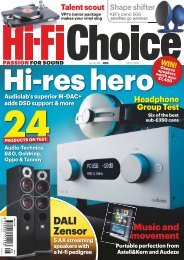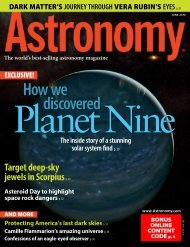You also want an ePaper? Increase the reach of your titles
YUMPU automatically turns print PDFs into web optimized ePapers that Google loves.
Rajasthan, 2002. Women in a step well<br />
West Bengal, 1983. Bicycles hang on the side of a train<br />
Steve on his gear and career<br />
What was your first camera?<br />
My first camera was a Miranda. Then I<br />
switched to a Pentax and then an Olympus.<br />
When I went to India in 1975 with my<br />
girlfriend, she had a Nikon and some<br />
lenses. I thought we should just use the<br />
same camera system and share the lenses,<br />
so I switched to Nikon, and I’ve been using<br />
it ever since – different models, of course.<br />
When did you switch to digital?<br />
My colleagues and I at National<br />
Geographic thought we’d be able to see out<br />
our careers shooting film, even into the<br />
late 1990s. But with time, it became clear<br />
that the train was leaving the station and<br />
we’d better get on it. It was clear that<br />
this was the future, like going from a<br />
typewriter to a laptop, and you could<br />
either jump in early or late.<br />
I love digital. I think it’s a huge leap<br />
forward in terms of picture making. I<br />
jumped in around 2005. Right now I’m<br />
using a Nikon D810, and it’s probably the<br />
best camera I’ve ever used. You can shoot<br />
in such extremely low light with it.<br />
Some of my favourite pictures going<br />
back 20 years can’t print very big because<br />
they were back-focused. I’d be in a really<br />
dark room and I’d be shooting away<br />
thinking, ‘This is a really great picture’,<br />
only to find out when I got home later<br />
and looked at them that they were all<br />
focused on the wall in the background.<br />
The thing with digital is that you can<br />
evaluate the focus, composition and<br />
light while you’re there. With film, you<br />
never really knew if you ‘had it’.<br />
Do you tend to travel light or with a<br />
bag full of lenses?<br />
I completed a major assignment a couple<br />
of weeks ago and used just a D810 and a<br />
24-70mm lens for the entire job. I use that<br />
lens for about 98% of my work now. When<br />
I’m walking on the street, I’ll take just one<br />
body and one lens. I’ll have a back-up body<br />
and lens back at the hotel, just in case.<br />
How has your job as a photojournalist<br />
changed over the years?<br />
When I started, unless I was published<br />
by a major magazine, my pictures just<br />
wouldn’t be seen. It was almost impossible<br />
to get your work published. The good news<br />
is that now we can self-publish, get our<br />
Steve currently uses<br />
Nikon’s 36MP<br />
full-frame D810<br />
pictures out on the internet, and if it’s<br />
really good people will recognise them.<br />
Today, there are much fewer assignments<br />
for the professional. But it was very tough<br />
when I was first starting too – you just<br />
have to persevere.<br />
What advice would you give to<br />
somebody starting out now?<br />
To become a professional photographer<br />
and make a living from it requires an<br />
enormous amount of time and effort.<br />
Unless you’re totally driven and obsessed<br />
about it, this may not be for you because it<br />
ends up consuming your whole life. If this<br />
is what you want to do, then it’s great.<br />
subscribe 0330 333 1113 I www.amateurphotographer.co.uk I 14 May 2016 23






